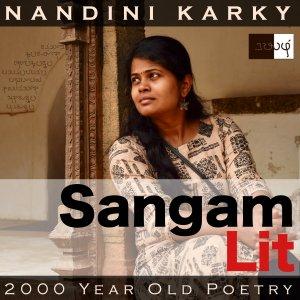Sangam Lit

Aganaanooru 53 – The love of my love
In this episode, we listen to a lady’s response to her friend’s consolation, as depicted in Sangam Literary work, Aganaanooru 53, penned by Seethalai Saathanaar. Set amidst the ‘Paalai’ or ‘Drylands landscape’, the verse offers intricate insights about elements of both nature and culture.
அறியாய், வாழி தோழி! இருள் அற
விசும்புடன் விளங்கும் விரை செலல் திகிரிக்
கடுங் கதிர் எறித்த விடுவாய் நிறைய,
நெடுங் கால் முருங்கை வெண் பூத் தாஅய்,
நீர் அற வறந்த நிரம்பா நீள் இடை,
வள் எயிற்றுச் செந்நாய் வருந்து பசிப் பிணவொடு
கள்ளிஅம் காட்ட கடத்திடை உழிஞ்சில்
உளூன் வாடிய சுரிமூக்கு நொள்ளை
பொரி அரை புதைத்த புலம்பு கொள் இயவின்,
விழுத் தொடை மறவர் வில் இட வீழ்ந்தோர்
எழுத்துடை நடுகல் இன் நிழல் வதியும்
அருஞ் சுரக் கவலை நீந்தி, என்றும்,
”இல்லோர்க்கு இல்” என்று இயைவது கரத்தல்
வல்லா நெஞ்சம் வலிப்ப, நம்மினும்
பொருளே காதலர் காதல்;
”அருளே காதலர்” என்றி, நீயே.
In this short trip to the drylands, we get to meet the lady, when the man has parted away, leaving her to lament, and when the confidante tries to console the lady, the lady says these words to her:
“You don’t know the truth, my friend, may you live long! The fast-moving, darkness-destroying orb that glows in the sky spreads its harsh rays and leaves the barren land with cracks many. Filling these fissures, the tall-trunked drumstick tree’s white flowers fall and spread all around the waterless, arid paths. Here, a sharp-teethed red dog walks on, along with its mate, filled with the suffering of hunger, passing by the cactus scrub jungle, where snails with curving shells, whose inner flesh is under duress, burrow themselves, upon the lebbeck tree’s spotted trunk in those deserted paths. The red dog and its mate find the only place to rest in the sweet shade of the inscribed hero-stones, built in the memory of those great warriors, who fell to the arrows of foes. On such a formidable drylands path, he walks on, urged by his heart that cannot bear to say no to those who come seeking to him. Beyond me, my lover’s true love is wealth. And here you are, saying that my lover will render his grace to me!”
Time to journey along with the man on those dried-up paths with shrivelled trees! The lady starts by making a firm declaration to her confidante that she doesn’t know the real thing, even as she blesses her. You have to admire this Sangam tradition of rendering a blessing to the listener, whenever one opposes their thought or says something against them. Isn’t it an effective technique to appease the negative reaction in them? Returning, we find the lady presenting us with a detailed description of the drylands, where there are the known elements, like the burning sun and barren land, but also new additions to pique our interest. First, she talks about how the white flowers of the drumstick tree wither and cover the cracks in the arid soil, then she moves on to a pair of red dogs or dholes, the Indian wild dogs. Projecting human qualities, the lady mentions how the female dhole is filled with hunger and the male is wandering, worrying about how to provide food and rest for its mate.
Next, the lady’s eyes falls on the cactus abounding in that scrub jungle, and also on a ‘Uzhinjil’ or ‘Vaagai’ tree. She zooms on to the spotted, cracked-up trunk of the said tree, and here, she points to snails sticking on the surface, saying their inner flesh is under much stress. When I read this, I said, ‘Wait a minute. Aren’t snails always found in wet places? I personally remember meeting these creatures, teeming after the showers, but not so much in the summers!’ On doing some research, I came across this fascinating detail that much like bears in the cold regions that take up ‘hibernation’ to conserve their heat in winter, these little cousins in the tropical world take up what is known as ‘aestivation’ to conserve their moisture in the dry summers. Apparently, the snails seal their shells with a film, thus protecting the soft flesh within from drying up, and burrow themselves in the mud or on trees. Truly these Sangam poets are the original naturalists! What precise observation in these lines about the behaviour of this little animal, which can be so easily overlooked!
Returning, we find the red dogs, walking on, panting, and finally seeing with relief, some hero stones, which the lady says, has been put up for great soldiers, who fought well and fell to the arrows of enemies. Here, the red dog and its mate find their only shade in this dried-up, forsaken place and rest there. The lady says such is the path the man walks now, all because he doesn’t know how to refuse those who come seeking to him, and concludes by declaring the man loves not her, but only wealth, and without realising this, the confidante was going on about how the man will return and shower his grace on the lady. In essence, here we find an instance of the lady refusing the confidante’s words to cheer her up. As all expressions of emotions are valid, we will let her be, and hope that she’ll find the way to bear this pain of parting.
I wish to return to one nuanced mention in this verse about the hero-stone. The words used to describe it are ‘Ezhuthudai Nadukal’ meaning ‘Lettered Hero-stone’, which implies that those warriors were named and celebrated, revealing to us, a highly literate society, two thousand years ago. An intuitive voice in me whispers that hero stones could be the original precursors of organised religion, which inspired the writing of epics about gods and their greatness. More than anything, amazed by how a few lines of poetry can conceal within so many launch pads for reflection about the past and present!






 Visit Podcast Website
Visit Podcast Website RSS Podcast Feed
RSS Podcast Feed Subscribe
Subscribe
 Add to MyCast
Add to MyCast